How Had I Never Seen... "The Wind Rises"?
 Tuesday, July 18, 2023 at 12:00PM
Tuesday, July 18, 2023 at 12:00PM 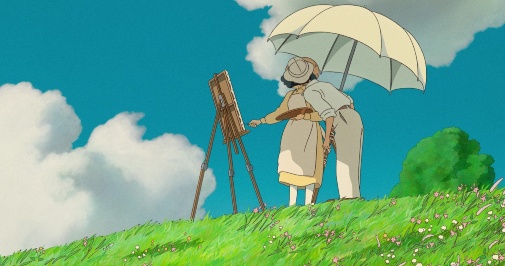
Hayao Miyazaki has been announcing his retirement for over a quarter century, each new project since Princess Mononoke received like a potential swan song. Such is the case of his latest flick, the enigmatic How Do You Live?, retitled The Boy and the Heron for the Anglophone market. After a lead-up to release that saw no promo beyond the poster, the film was finally seen by the Japanese public, enjoying its big opening last week. And yet, few folks are keen on sharing details about the animated project, including the narrative's basic premise. While the rest of the world waits for an opportunity to glimpse Miyazaki's latest "last" picture, it's an excellent time to watch the not-so-final career-capper that came before, which, to my great shame, I had never seen.
This July, The Wind Rises celebrates its 10th anniversary, something worth celebrating as we prepare to see another auteur's exploration of an inventor whose efforts resulted in mass death during WWII. Not that Miyazaki's biopic of engineer Jiro Horikoshi, whose fighter designs defined Japanese air force in the 30s and 40s, is attempting the same IMAX-sized scale as Nolan's Oppenheimer…
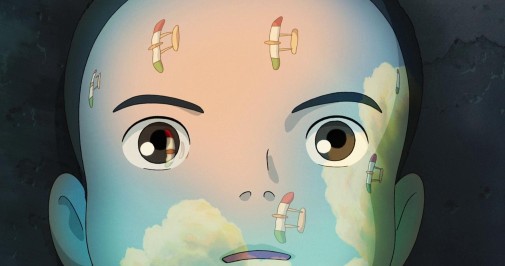
Between real life and the oneiric kingdom, The Wind Rises moves along its protagonist's life like a biopic interrupted. It starts away from the realm of dramatized fact, considering a boy's aspirations taking form while he sleeps. Wordless, for text is unnecessary, the beginning is the dream of young Jiro. In this reverie, kissed by the miracle of flying, a bird-like plane takes the adolescent boy to soaring heights before a monstrous vehicle cuts through the clouds. It's a war machine, like a whale whose enormous beard dangles pulsing bombs over the land, weaponry animated as if it has a living beating heart, evil and destruction as man-made demons.
Jiro wakes before those beasts spew their fiery death, but Miyazaki has planted an idea seed within the viewer. It's a reminder that for all that it empathizes with the aviator's wonderment, The Wind Rises is aware of what his dreams birthed. Though the narrative circumvents direct representation of wartime bloodshed, a mighty tension pervades every minute of its two-hour-plus running time. Miyazaki leads his audience to ponder notions of responsibility his "hero" fails to grasp. Or perhaps it's not a matter of self-committed ignorance. Maybe it's a consequence of having eyes turned up, so focused on the skies they forget to look below.
"Fighting is never justified," says his mother, and so roars the picture's director, whose anti-war, anti-fascist beliefs have been evident all over his filmography. Jiro, however, listens to another voice, that of Italian aircraft designer Giovanni Battista Caproni. He's not real, per se, but a manifestation of ambitions given human form in the boy's head. Regardless, he's true enough within the subjective experience of The Wind Rises, real enough for Jiro to heed his siren call – "Airplanes are not tools for war. They are not for making money. Airplanes are beautiful dreams. Engineers turn dreams into reality." If only it were so simple, ideal, so separate from the truth of technology in service of human folly.
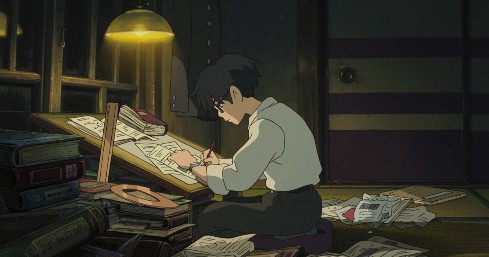
As Jiro grows, the dreams persist. For all its by-the-books biopic storyline, the structure of The Wind Rises is constantly repudiating tradition by abstracting reality into fantasy, losing itself within the crevasses of the protagonist's imagination. These waking and not-so-waking dreams consistently break the tale's flux, getting the viewer drunk on Jiro's skewed perspective and just how much these machines mean to him. Enough to make us understand the conflict between the engineer's dream and the bellicose purpose of his creations. It's subtle and adult, by far Miyazaki's most grown-up animation until then.
Going further, the project represents an act of self-reflection in a way no other Ghibli project can claim, functioning as its auteur's mirrored meditation. Self-portraiture disguised as the portrait of another, The Wind Rises sometimes feels like a lacerating confession about Miyazaki's successes and failings as man, husband, dreamer. Entire character composites seem designed to invoke the ghosts in the director's past, while the dramatization of engineering is made to look much like the animation labor. Perhaps most importantly, the emphasis on Jiro's neglect of a fictitious wife reflects Miyazaki's publicized feelings about how his obsessive investment in work led him to short-shrift his own spouse.
Beyond such specificity, it's about creatives on a broader scope, which helps explain the casting of fellow filmmaker Hideaki Anno in the role of adult Jiro. In that regard, it pairs well with something like Spielberg's The Fabelmans, both as a celebration of creation and an implicit indictment of it. The artist, the engineer, loses themselves in their process to the point of no return. They disconnect in the passive act of self-alienation, becoming divorced from the world, life, and other people, even those they most love. But of course, the film's gambit also helps us comprehend, deep within, why one would let themselves fall into the abyss.
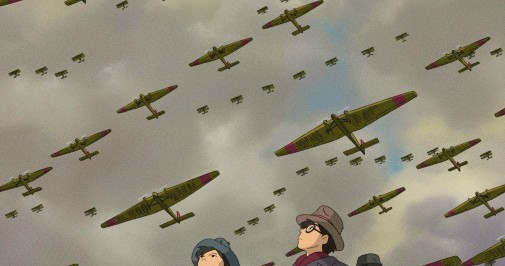
Hayao Miyazaki has always been obsessed with flying, objects in airborne motion, and aircraft design. These affections proliferate through his work, whether it's a dragon taking a little girl to heavens unknown or an entire cityscape lifted in the air, reaching zenith with The Wind Rises and Porco Rosso before it. The animation of flight is no mere adornment or narrative illustration. Instead, it's an act of sharing on the verge of hypnotic spell-cast, the cineaste transmitting his love to us in delirious baton pass, making us as fixated as he is if only for the duration of a feature. That is perhaps his most outstanding achievement as storyteller and animator.
Because it's all in the animation, its contrasts. Notice the simplicity in the rendition of human shapes, the spaces they inhabit. And then compare to the flying machines, so complicated in engineered detail, every rivet accounted for, metal waves and fishbone curves drawn with such love it's almost palpable. They are artificial constructions, yet they breathe with a living energy that seems bigger than life, mechanism above organism. It's transcendence in 2-D terms, but it's not even the most startling piece of animation in a movie whose aerial symphonies are both respite and cause toward a cosmos caught in cyclical nightmare.
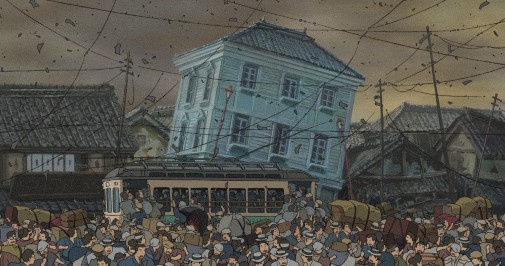
My mind wanders to Jiro's train travels to Tokyo as the Great Kanto earthquake hits. Miyazaki and his team unleash the apocalypse on-screen, the schism hitting like a swoosh of cracking earth within deep silence. Fire seems to seep from the rock, a dragon's roar that extends as a shockwave of concentric circles. Neighborhoods rise and fall as if the city's foundations were breathing a deep breath, smoke and water spilling forth to render the nauseous idea of a monumental body torn apart. The horror happens in a flash, but it doesn't stop so soon, prevailing with world-ending clouds of ash rising in the air, growls from deep below cursing at the evacuating crowds.
Or else consider how engines bleed as lungs do, oil spill rhyming with red cascades from mouth and nose on painted canvas. A crimson gash over the pastoral peace, nightmares of conjecture as a man imagines what his beloved is going through without him, dying alone. Such commonplace facets of romantic melodrama are twisted into lyricism in the same way history is but a transient breath. From 1936 to 1945, we go in one movement of immense beauty and ascetic avoidance. Jiro's naïve dream flying gorgeous formations, high above a smoke cloud bigger than anything you can conceive, a destroyed world burning to cinders below. His kingdom of dreams is a land of the dead.
Ultimately, The Wind Rises is perchance Miyazaki's most carefully cut picture as it moves between reality and imagination, present time and remembered regret. It further represents the peak of his balancing of animation and sound, silence often as powerful as cacophony, littered with effects that make your insides tremble in place. In all these ways, it's as if the director's most straightforward effort is also his most complex, his ugliest and his most ravishing. Sometimes self-contradicting, the film is the artist's shattered notions and the engineer's maligned path. It's a song of awed fascination toward killing machines, pulling the audience toward an uncomfortable place whilst smoothing the fall with sentiment and visual poetry. Before you know it, it's over, gone and beautiful like the wind.
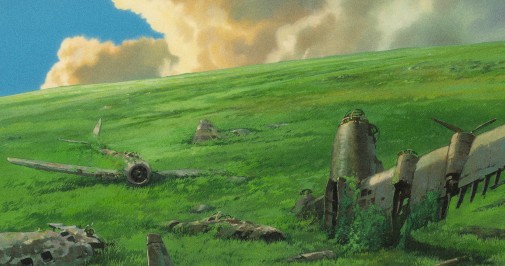
You can find The Wind Rises streaming on Max. As for Miyazaki's latest, The Boy and the Heron is scheduled to arrive in American theaters later this year, courtesy of GKids.



Reader Comments (2)
I saw this film in the theaters though in its dubbed version which wasn't that bad as I just love the animation and Miyazaki's visuals. He's a god in cinema.
This is a phenomenal film and I wish more people had seen it. I'm just glad it's streaming somewhere since it wasn't for a while and should absolutely be discovered by all audiences. Thanks for the spotlight!